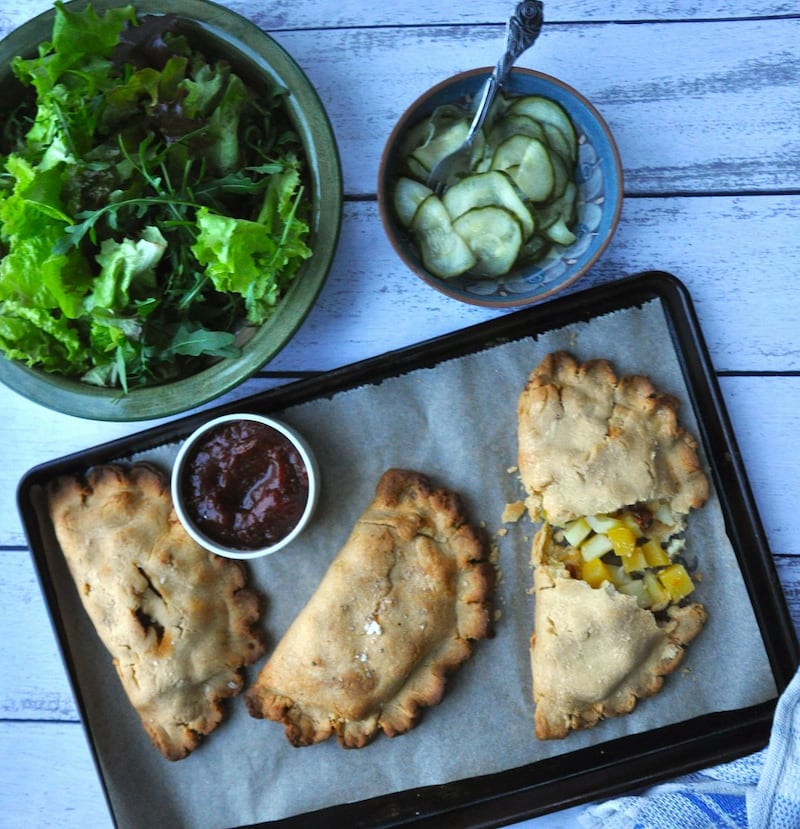[ @lilly_higgins_Opens in new window ]
Cornish pasties are such a fantastic design. The buttery pastry crust seals in the steam, cooking the filling perfectly while providing the ideal packaging. Traditionally, these hot pastry crescent shapes would have been handed to tin miners in Cornwall during the 17th and 18th centuries.
The hot pastry would provide warmth when placed in their pockets early in the morning and would provide energy by lunchtime, being self-contained, self-insulated and packed full of nutrients. Sometimes one end would have a little jam or fruit inside, for dessert. The edges can be twisted or crimped, sealed with a fork or folded. Often these edges served as a disposable handle as the miners’ fingers would be covered in arsenic-laden dust.
Versions
Over time, this little handheld pie has been made in many different ways, and most countries have their own version, from Portuguese empanadas to Jamaican patties.
I still love the traditional turnip and potato filling though. And adding some cubed chorizo balances the sweet turnip nicely, too.
I also love adding leftovers to these little pies, from roast chicken or pork to beef and lamb. Even leftover gravy can be used to bind the ingredients, but ensure you seal the pastry really well when adding a sauce or gravy.
A traditional meatless version was called the herby pie, where wild ramsons, leeks, wild herbs and parsley were mixed with a little clotted cream and used as a filling.
The pastry can be made well in advance. In fact, the pasties can be made the day before and baked just before serving.
The novelty value of having a little dish to yourself will never fade in our house. I serve them with some pickled cucumber, piccalilli or green salad. I love tomato relish or chutney with them too.
Turnip is such a wonderful vegetable that is often cast to the wayside in favour of easier to cook root vegetables. I love turnip though. It is perfect for soups and stews. It becomes buttery and quite sweet. The texture holds when boiled and it’s particularly good as a mash or puree, along with carrots. It’s one of those fantastically savoury vegetables that has so many uses. Turnip oven chips are delicious, too.
TURNIP AND CHORIZO CORNISH PASTIES
Makes six

For the pastry:
500g strong white flour
250g butter, cubed
1 egg
2-3tbsp cold water
For the filling:
230g potatoes, peeled and cubed
200g turnip, peeled and cubed
120g chorizo, cubed
Salt and pepper
Method
1 Preheat the oven to 180 degrees Celsius. Line two baking trays with greaseproof paper.
2 Place the flour and cubed butter into the bowl of a food processor. Blitz till it gains a sand-like consistency. Add the egg and 2-3tbsp cold water. Blitz till it forms a smooth dough. You'll soon know if you need more water. This needs to be a smooth dough and not wet at all. Remove the dough from the bowl and knead till smooth. Cover with an upturned bowl for 10 minutes.
3 Meanwhile, prepare the filling. Mix the cubed vegetables with the chorizo in a bowl. Season generously with black pepper and salt.
4 Divide the pastry into six pieces. Roll each piece into a circle and add a few spoonfuls of filling. Brush the edge with water then fold over the pastry and seal in a crescent moon shape. Pinch the edges closed using a fork or crimp with your fingers. Brush the outside of the pasties with a little egg wash. Bake for 35-40 minutes till golden.
5 Serve while still warm with salad and pickles.



















